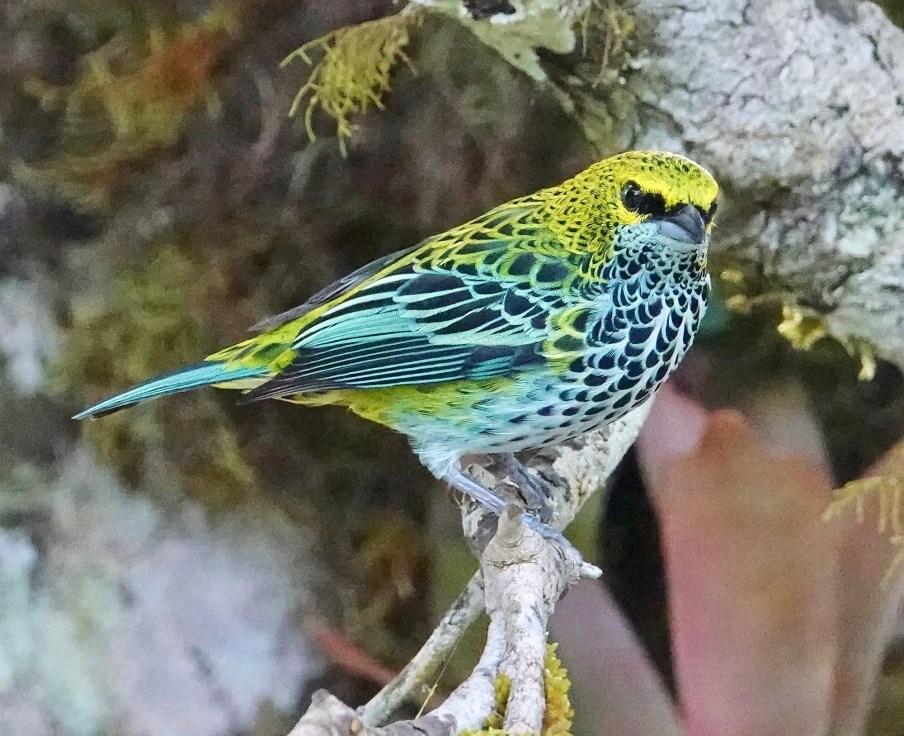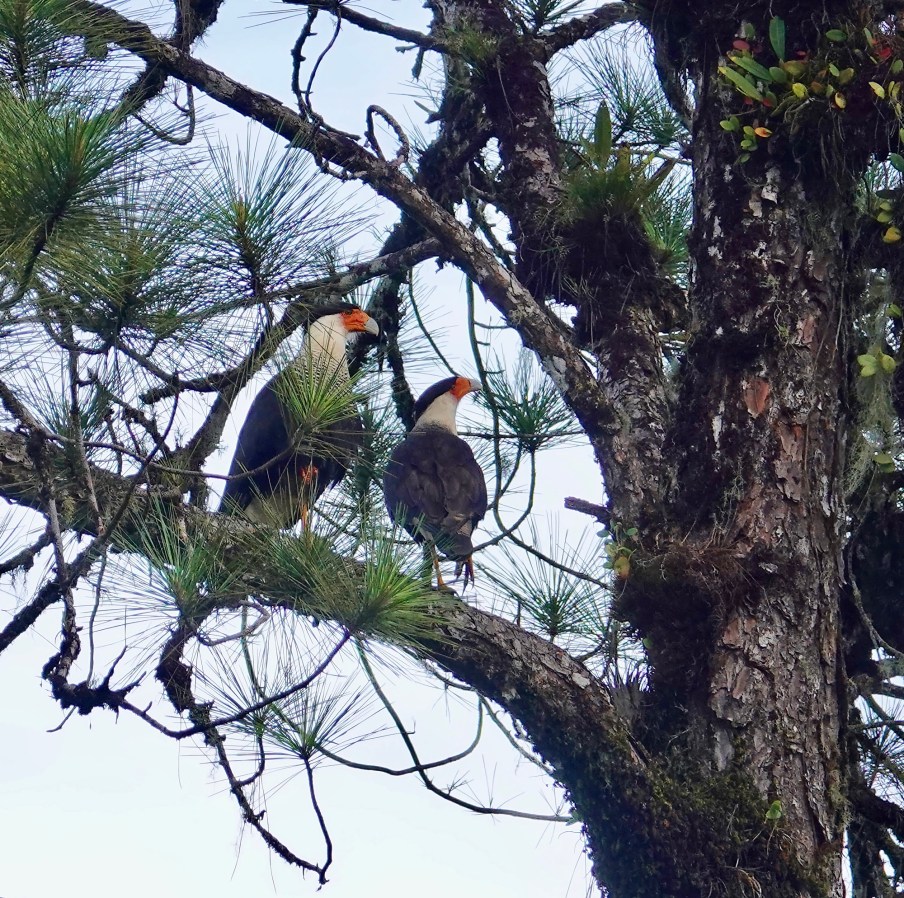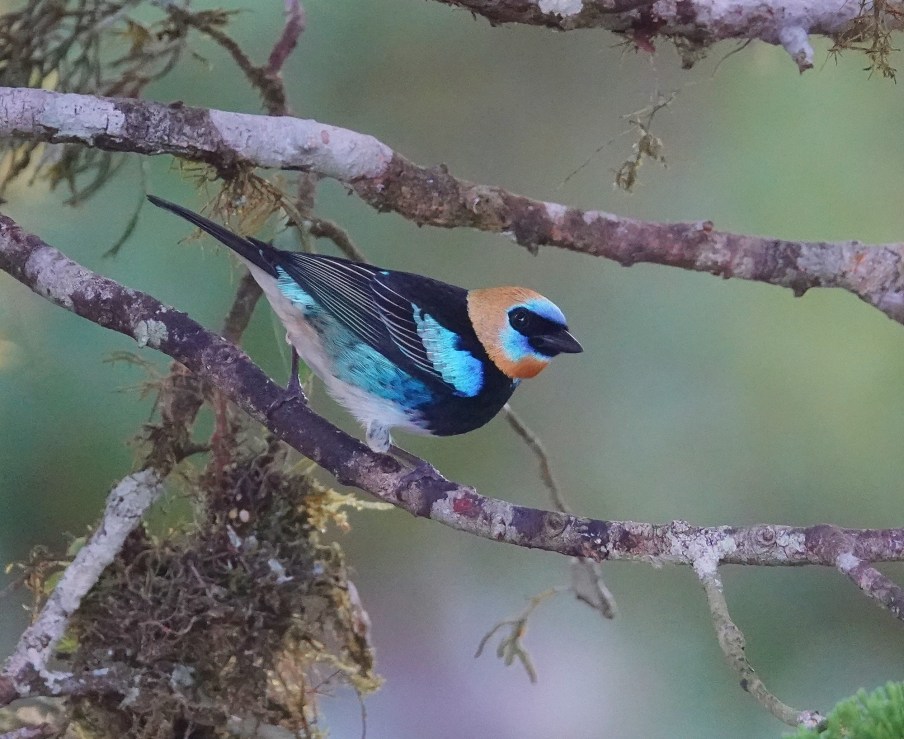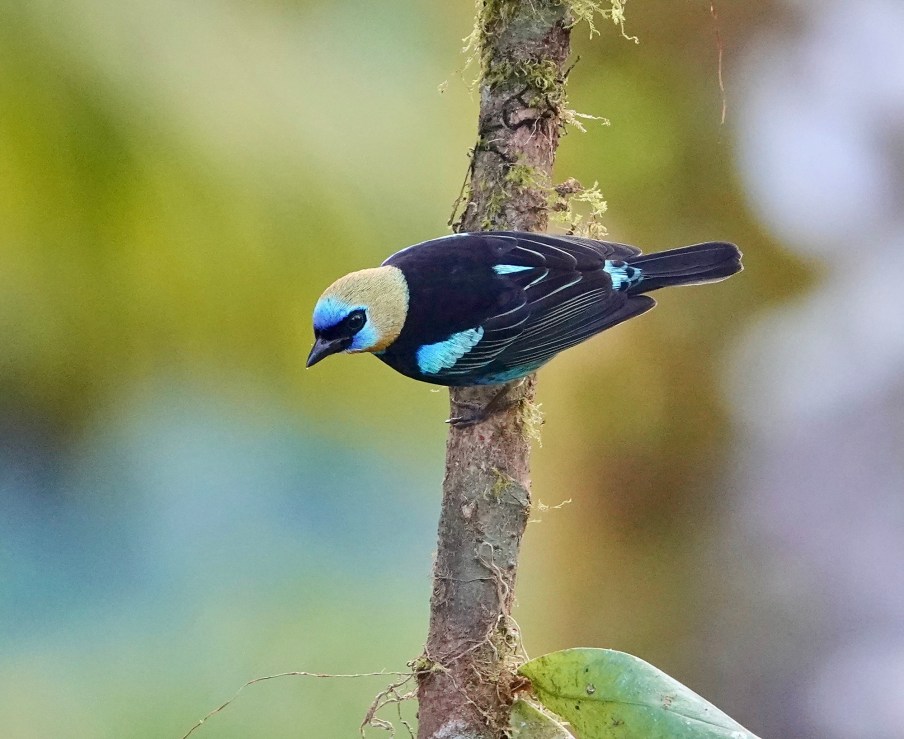Posts in Category: Costa Rica
Green Honeycreeper

Green Honeycreeper: Los Cusingos Bird Sanctuary, Pérez Zeledón, Costa Rica, December 2021 — We left Las Cruces Biological Research Station and headed up toward our high elevation stop at San Gerardo de Dota in the Savegre Valley, with packed lunches which we intended to eat at the home of Alexander Skutch, perhaps the best known ornithologist of his time due to his many books on birds and tropical ecology. Skutch was among the first to closely relate birds to the habitat they frequented, and to study the effect that even minor changes in habitat have on the birds. After his death, his home in Costa Rica was preserved as a avian sanctuary and a memorial to his life and work. This Green Honeycreeper was there to greet us in the extensive natural gardens. This is, despite not looking much like one, a tanager…honeycreepers are a small sub-division of the colorful tropical tanagers specialized for fruit eating. It is the female that is actually green, while the male, as you see, is more turquoise, but so distinctive as to be unmistakable. Sony Rx10iv at 600mm equivalent. Program mode with my custom birds and wildlife modifications. Processed in Pixelmator Photo and Apple Photos. ISO 400 @ f4 @ 1/500th.
Buff-throated Saltator

Buff-throated Saltator: Las Cruces Biological Research Station (OTS), San Vito, Costa Rica, December 2021 — The Buff-throated Saltator is one of the most common birds around feeding stations in Costa Rica, on both the Caribbean and Pacific slopes…from the lowlands well up into the foothills…so not so exciting to see it at Las Cruces, but still a good bird 🙂 Sony Rx10iv at 591mm equivalent. Program mode with wildlife modifications and multi-frame noise reduction. Processed in Pixelmator Photo and Apple Photos. Equivalent ISO 2500 @ f4 @ 1/500th.
Fiery-billed Aracari: my best side?


Fiery-billed Aracari: Las Cruces Biological Research Station (OTS), San Vito, Costa Rica — Another visit from the Fiery-billed Aracaris. This bird seemed to want to show us every side. Aracaris are active birds…never still…always hopping around on the branch. And they are very focused…intent on food mostly…but also very aware of the other birds of the flock. Sony Rx10iv at 595mm equivalent. Program mode with wildlife modifications and multi-frame noise reduction. Processed in Pixomator Photo and Apple Photos. Equivalent ISO 2000 @ f4 @ 1/500th.
Female Scarlet-rumped Tanager (with bonus bird)

Scarlet-rumped Tanager (female) and Golden-hooded Tanager, Las Cruces Biological Research Station, San Vito, Costa Rica, December 2021 — I mentioned that the Passerini’s and Cherrie’s Tanagers were considered separate species, each with an isolated range on either cost of Costa Rica (no overlaps)…at least for a while. They were once considered the same species, named Scarlet-rumped Tanager…and then the AOU (the bird naming committee) decided they were different, based on range, and on the obvious differences in the plumage of the females (the males are identical), but recently ornithologist have come up with a new method to study species, called the “playback method”. They play recorded songs and calls of an apparently closely related species, to determine if the birds under study respond as they do to their own calls and songs. In the case of Passerini’s and Cherrie’s Tanagers, both respond equally as well to the other’s songs and calls…making it very likely that they are the same species, or at least that they would interbreed if their ranges overlapped. This inspired genetic studies to follow up…and indeed they appear to be the same species, just separated by a mountain range. The Golden-hooded Tanager just had to get into the photo. Sony Rx10iv at 591mm equivalent. Program mode with wildlife modifications and multi-frame noise reduction. Processed in Pixelmator Photo and Apple Photos. Equivalent ISO 2500 @ f4 @ 1/500th.
Blue-headed Parrot


Blue-headed Parrot: Las Cruces Biological Research Station, San Vito, Costa Rica, December 2021 — It really is amazing how many different parrot species we saw at the Wilson Botanical Gardens at Las Cruces. What is more amazing, is the we were seeing so many good birds that no one really remarked on the number of parrots 🙂 This is the Blue-headed Parrot…for obvious reasons…terrible lighting, and way too far away, but still great to see. These took special effort in post-processing 🙂 Sony Rx10iv at 600mm equivalent. Program mode with my custom birds and wildlife modifications. Processed in Pixelmator Photo and Apple Photos. ISO 200 @ f4 @ 1/500th. +2EV exposure compensation for the strong backlight (and then a lot of pumping up and black-point adjustment, as well as deep cropping and enlargement, in post).
More action over papaya

Golden-crowned Euphonia (male and female), Scarlet-rumped Tanager: Las Cruces Biological Research Station (OTS), San Vito, Costa Rica, December 2021 — The male Golden-crowned Euphonia seems to think the papaya rind belongs to him and his mate, while the Scarlet-rumped Tanager begs to differ. I will probably share more on this in another post, but the Scarlet-rumped Tanager was considered two species until recently, Passerini’s on the Caribbean slope and Cherrie’s on the Pacific. This would be a Cherrie’s. Sony Rx10iv at 591mm equivalent. Program mode with wildlife modifications and multi-frame noise reduction. Processed in Pixelmator Photo and Apple Photos. Equivalent ISO 3200 @ f4 @ 1/500th.
Meeting over papaya

Speckled and Silver-throated Tanagers: Las Cruces Biological Station, San Vito, Costa Rica, December 2021 — I don’t often post photos of birds actually at the feeder, but sometimes the interactions of contrasting species that take place there are just too good to pass up. Both of these birds are common in mixed feeding flocks at the right elevations in Costa Rica (the Silver-throated is common everywhere in Costa Rica…I think it might cover the widest range in elevation of any Central American Tanager) so it is no surprise to see them together at the feeding station, but for those of who only visit Costa Rica once a year, it is still a rare treat. Sony Rx10iv at 591mm equivalent. Program mode with wildlife modifications and multi-frame noise reduction. Processed in Pixelmator Photo and Apple Photos. Equivalent ISO 1600 @ f4 @ 1/500th.
Specked Tanager

Speckled Tanager: Las Cruces Biological Research Station (OTS), San Vito, Costa Rica — I have shared this bird before, but not this photo, which is arguably the best of my Speckle Tanager shots from our visit to the Wilson Botanical Gardens and Las Cruces. Such an amazing bird! They are listed in my field guides as “common”, and often included in mixed feeding flocks, so relatively easy to see…if you happen to be in the foothills and mid-elevations of Costa Rica or Panama, or in scattered regions in northern South America…so not so common for most of us. Sony Rx10iv at 600mm equivalent. Program mode with wildlife modifications and multi-frame noise reduction. Processed in Pixelmator Photo and Apple Photos. Equivalent ISO 5000 @ f4 @ 1/500th.
Crested Caracara


Crested Caracara: Las Cruces Biological Research Station, San Vito, Costa Rica — Just a pair of Crested Caracaras…same as you can see in south Texas, Arizona, or central Florida. Oh hum. But these were the first Crested we saw in a week and a half in Costa Rica…lots of Yellow-headed, which is a real treat for we North Americanos, but no Crested until we got to the Wilson Botanical Gardens at Las Cruces. These were wee and far, it a tree across the whole width of the garden, but with a little help from the machine learning maximum resolution algorithm in Pixomator Photo, the Sony at 600mm was able to bring them in. I have to say, I think these might have been my first perched Crested Caracaras anywhere. Sony Rx10iv at 600mm equivalent. Program mode with my custom birds and wildlife modifications. Processed in Pixomator Photo and Apple Photos. ISO 200 @ f4 @ 1/500th. Plus 1.3 EV for the backlight.
Golden-hooded Tanager



Golden-hooded Tanager: Las Cruces Biological Station (OTS), San Vito, Costa Rica — These are not the first Golden-hooded Tanagers I have shared, even from our most recent December trips to Costa Rica. Certainly an eye-catching bird, and common around dwellings and in mixed feeding flocks. All these shots were around the banana platform off the patio by the dinning hall at Las Cruces. As the morning progressed the light got better. Sony Rx10iv at 600mm equivalent. Program mode with wildlife modifications and multi-frame noise reduction. Processed in Pixelmator Photo and Apple Photos. ISO 2500, 1600, and 1250 @ f4 @ 1/500th.